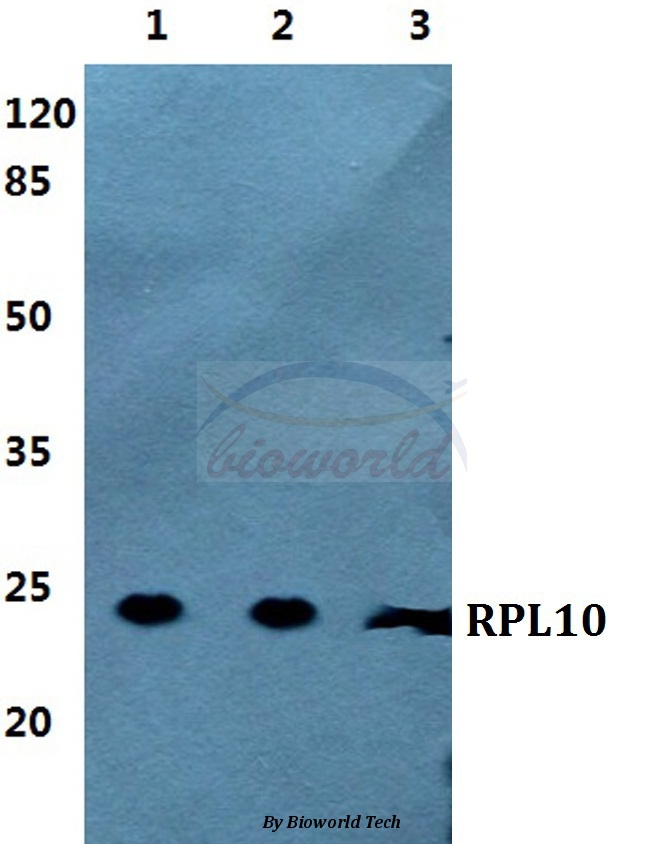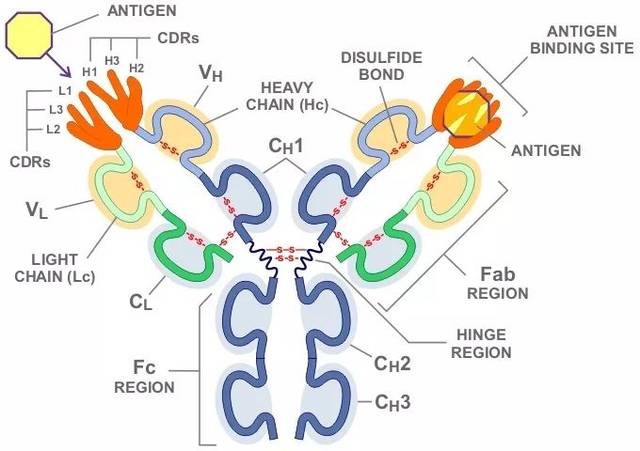Product Name :
RPL10 polyclonal antibody Background :
The c-Jun protein is a major component of the transcription factor AP-1, originally shown to mediate phorbol ester tumor promoter (TPA)-induced expression of responsive genes through the TPA-response element (TRE). The Jun proteins form homo- and heterodimers which bind the TRE, while Fos proteins are active only as heterodimers with any of the Jun proteins. Fos/Jun heterodimers have a much higher affinity for the TRE than Jun homodimers. A distant member of the MAP kinase family, designated c-Jun NH2-terminal kinase (JNK1) functions to regulate c-Jun by phosphorylation at the amino terminal serine regulatory sites, Ser 63 and Ser 73). RPL10 has been described as a transcription factor that can function to bind DNA directly or alternatively can interact with c-Jun to inhibit transactivation of AP-1 promoter driven reporter vectors by Jun-Jun homodimers. RPL10 is highly conserved throughout eukaryotic evolution and is apparently a member of a multi-gene family. Product :
Rabbit IgG, 1mg/ml in PBS with 0.02% sodium azide, 50% glycerol, pH7.2 Storage&Stability :
Store at 4°C short term. Aliquot and store at -20°C long term. Avoid freeze-thaw cycles. Specificity :
RPL10 polyclonal antibody detects endogenous levels of RPL10 protein. Immunogen :
Synthetic peptide, corresponding to the 157-202 of Human RPL10. Conjugate :
Unconjugated Modification :
Unmodification
RPL10 polyclonal antibody Background :
The c-Jun protein is a major component of the transcription factor AP-1, originally shown to mediate phorbol ester tumor promoter (TPA)-induced expression of responsive genes through the TPA-response element (TRE). The Jun proteins form homo- and heterodimers which bind the TRE, while Fos proteins are active only as heterodimers with any of the Jun proteins. Fos/Jun heterodimers have a much higher affinity for the TRE than Jun homodimers. A distant member of the MAP kinase family, designated c-Jun NH2-terminal kinase (JNK1) functions to regulate c-Jun by phosphorylation at the amino terminal serine regulatory sites, Ser 63 and Ser 73). RPL10 has been described as a transcription factor that can function to bind DNA directly or alternatively can interact with c-Jun to inhibit transactivation of AP-1 promoter driven reporter vectors by Jun-Jun homodimers. RPL10 is highly conserved throughout eukaryotic evolution and is apparently a member of a multi-gene family. Product :
Rabbit IgG, 1mg/ml in PBS with 0.02% sodium azide, 50% glycerol, pH7.2 Storage&Stability :
Store at 4°C short term. Aliquot and store at -20°C long term. Avoid freeze-thaw cycles. Specificity :
RPL10 polyclonal antibody detects endogenous levels of RPL10 protein. Immunogen :
Synthetic peptide, corresponding to the 157-202 of Human RPL10. Conjugate :
Unconjugated Modification :
Unmodification
-
 Western blot (WB) analysis of RPL10 polyclonal antibody at 1:500 dilution Lane1:MCF-7 cell lysate Lane2:Raw264.7 cell lysate Lane3:PC12 cell lysate
Western blot (WB) analysis of RPL10 polyclonal antibody at 1:500 dilution Lane1:MCF-7 cell lysate Lane2:Raw264.7 cell lysate Lane3:PC12 cell lysate
Bioworld Biotech only provide peptides for our antibodies and do not provide additional peptide customization services.
Price/Size :
USD 368/1mg/vial
Tips:
For phospho antibody, we provide phospho peptide(0.5mg) and non-phospho peptide(0.5mg).Describe :
Blocking peptides are peptides that bind specifically to the target antibody and block antibody binding. These peptide usually contains the epitope recognized by the antibody. Antibodies bound to the blocking peptide no longer bind to the epitope on the target protein. This mechanism is useful when non-specific binding is an issue, for example, in Western blotting (WB) and Immunohistochemistry (IHC). By comparing the staining from the blocked antibody versus the antibody alone, one can see which staining is specific; Specific binding will be absent from the western blot or IHC performed with the neutralized antibody.Formula:
Synthetic peptide was lyophilized with 100% acetonitrile and is supplied as a powder. Reconstitute with 0.1 ml DI water for a final concentration of 10 mg/ml.The purity is >90%,tested by HPLC and MS.
Storage:
The freeze-dried powder is more stable. For short time at 2-8°C. For long term storage store at -20°C.
Note :
This product is for research use only (RUO only). Not for use in diagnostic or therapeutic procedures.
 RPL10 polyclonal antibody
RPL10 polyclonal antibody  Datasheet
Datasheet COA
COA MSDS
MSDS SHIP
SHIP